Aussie Flags
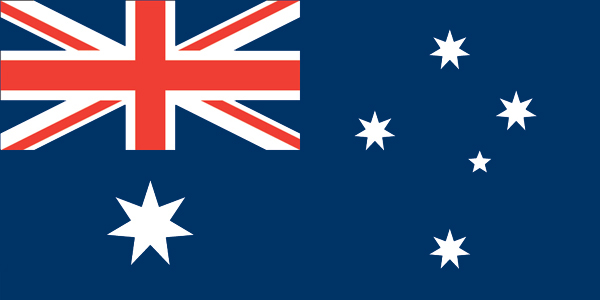
Australian National Flag
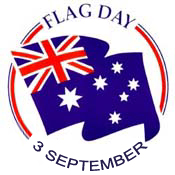
The Australian National Flag features the five stars of the Southern Cross constellation and the Commonwealth Star, and the combined crosses of St George, St Andrew and St Patrick. The union of crosses reflects Australia’s European derived civilisation. The Commonwealth Star with its seven points represents the unity of the six Australian states and the seventh point stands for all Australian Territories.

Eureka Flag
The "flag of blue and silver stars" was raised by Gold miners in Ballarat, Victoria in 1854. At a meeting of 12,000 miners on
29 November it was flown as a symbol of people power in the face of dictatorial authority. The flag was dark blue with five stars representing the Southern Cross, the stars joined together by a broad white cross. On 3 December colonial troops and police stormed the diggers stockade, slaughtering some 30 plus miners and the flag torn down. The Eureka Stockade and its flag has become a historical symbol of the wider struggle by Australians for democracy and national identity. The original flag is now on public display at the Ballarat Fine Art Gallery. The Eureka Flag continues to evoke strong feelings of Australianism.
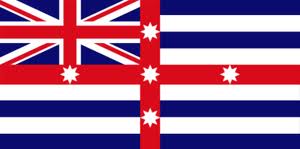
Murray River Flag
This unique flag flew on the paddle steamers on the Murray River from 1853. Though the flag was on many of the river barges, no example has survived. The flag was described by a 1854 journalist's report as "it bears a red cross with four horizontal bars of blue, the cross being charged with five stars as emblems of the different Australian colonies". The reconstruction is from the original description, and continues to be used on the river and in the region. A slightly different version of the flag is flown in areas of South Australia.

Lambing Flat Flag
The goldields in southern NSW in the early 1860s became a source of disturbance directed against Chinese fossickers due to their activities. At Lambing Flat (now Young) on 30 June 1861 miners fed up with the Chinese presence drove them out. A public meeting of miners had been advertised by the flag painted on the canvas flap of a tent. At its centre was a Scottish St. Andrews Cross with four white stars. The "No Chinese" slogan embodies an important ideal for our Australian Identity. It is significant in showing the early emergence of the Southern Cross as an Australianist symbol. The banner is on display at the Lambing Flat Museum.
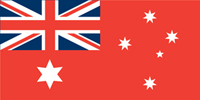
The Australian Red Ensign
The 1901 flag design competition led to this flag being formallly adopted on 20 February 1903. A further change to the points of the Federation Star occurred from 23 February 1908. Initially the blue version of the Australian flag was limited to government use and the red was intended for private use on ships. It was common practice for the British Red Ensign to be used onshore, and accordingly the Australian Red Ensign came into popular use by citizens.

Federation Flag.
In the mid-1880s efforts to join the separate colonies into an Australian federation increased. The earlier Australian Ensign was revived for use on land and in printed materials to promote federation, particularly in NSW and Queensland. In the absence of an official Australian flag in January 1901 this Federation Flag was widely used. When Prime Minister Edmund Barton submitted the winning design in the Federal flag competition to the British authorities in 1902, he also included the Federation Flag as an alternative for adoption as the new Australian national flag. Usage as an unofficial Australian flag continued until Word War I.
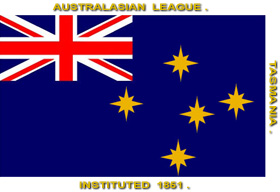
Anti Transportation Flag.
The League for the Abolition of Transportation was formed in Launceston as an opposition to the transportation of convicts to Australia, and establishing branches in other colonies by 1851. At a meeting in Melbourne a large flag was unfurled - it was a blue ensign upon which were four golden stars forming the Southern Cross. This is the first known flag using the Southern Cross in a natural arrangement and it is considered to be a significant antecedent to the current Australian National Flag. The original flag is in the collection of the Queen Victoria Museum and Art Gallery, Launceston. The League was dissolved when transportation to Tasmania ended in 1853.
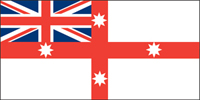
National Colonial Flag.
Captain John Bingle wrote his memoirs in 1881 in which he stated that Captain John Nicholson and he had designed a flag for use as a national colonial flag for Australia. He claimed that the flag had been approved by NSW Governor Sir Thomas Brisbane in 1823, athough no other record of the flag or any approval has been found. The flag is promoted as the earliest Australian flag and the first to use the Southern Cross.
AUSSIE HERITAGE - NOT NEGIOTABLE!








